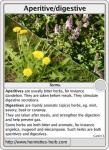
 Generally speaking, there are two types of herbs used for the digestion. They are:
Generally speaking, there are two types of herbs used for the digestion. They are:
• aperitives, that is, bitter herbs taken before meals
• digestives, that is, aromatic herbs taken after meals.
Bitter herbs are taken 20–30 minutes before meals, as they make digestive juices flow from the mouth all the way to the intestines.
Aromatic herbs are taken after meals to help with digestion and to avoid gas forming in the gut.
There are quite a few bitter herbs, for instance, dandelion (root and greens), burdock (leaf and seed), skullcap, hops (which is very cooling, so not for "cold" people), citrus peels (they're aromatic as well), artemisias (mugwort can affect your dreams, not always in a good way), angelicas, the yellow root and bark of both barberry and mahonia, and all parts of all plants in the Gentianaceae family.
Coffee and beer are everyday bitter beverages. Other bitter beverages are e.g. Angostura (which gets its bitter taste from hops), Campari (wormwood), Cinzano and Fernet Branca.
Spicing up your food helps both your appetite and your digestion.
Common spices are the leafy ones (dill, parsley, lovage, thyme, sage etc.), black, white and green pepper, allspice, mustard and ginger. Among others.
Some aromatic herbs are taken as digestives, e.g. caraway, fennel seed, aniseed and mint. There are quite a few digestive liquors, often originally from monasteries, for instance Gammel Dansk, Underberg, Unicum, Fernet Branca and Jägermeister. They were invented to get rid of the extreme constipation of winter diets, a few hundred years ago.
Henriette's herb cards: order yours here!

